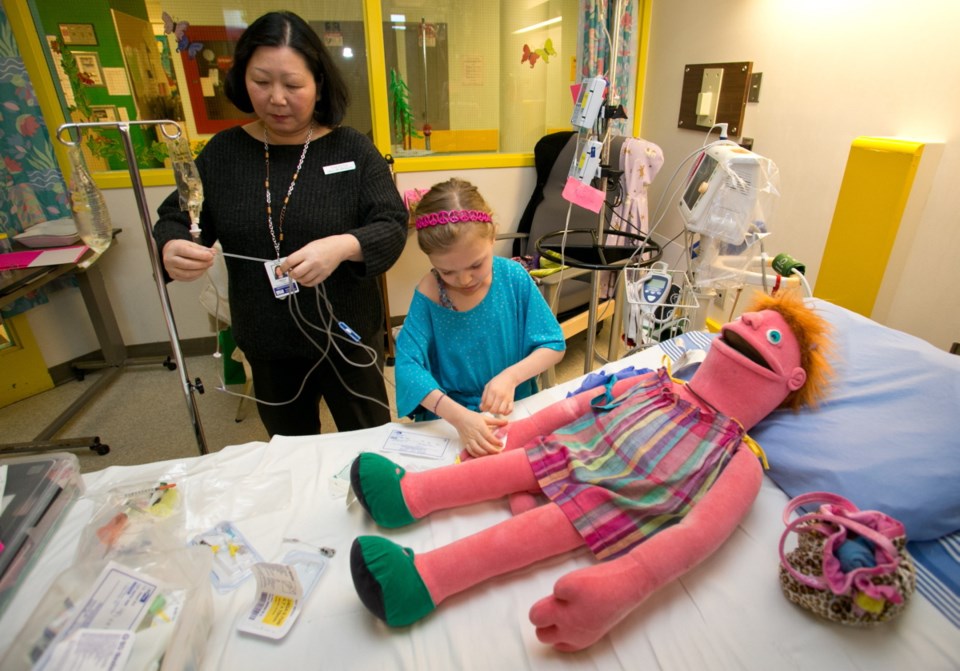When Maya Bosdet was getting ready to go to the hospital for an MRI, the procedure was old news for the Saanich seven-year-old.
Maya had already performed an MRI on two of her 30-odd stuffy toys, the plush frog and cat. She even helped fashion the MRI machine out of a cardboard box. (The rear end was kept closed to distinguish it from a CT machine.)
“We had done an MRI for my stuffies,” said Maya. “Not the real one — we made an MRI machine.”
She built the pretend MRI machine at Victoria General Hospital with the help of a child-life specialist from Vancouver Island Health Authority. These specialists, two full-time and two part-time, educate, reassure and prepare kids and their families prior to medical procedures or during hospital stays.
The team covers Victoria General Hospital, the Island’s principal children’s facility, from morning to late evening on weekdays and late afternoon onwards on weekends.
Theresa Low, one of the VIHA child-life specialists, said a prior consultation is a chance to engage children meaningfully in their treatment and ease any anxieties.
There are many ways to do that, she said, from using storyboard pictures about a visit to the hospital to dressing stuffed toys as patients and doctors for role play, and providing bubble blowers and flashing-light toys for distraction during injections.
She said the best way to start, however, is to sit down and get an idea of what the child and family need to know to remain calm through the procedure. “It’s not so much the toys,” said Low, who has more than 20 years’ experience helping families cope with hospital visits. “It’s more about making assessments and learning how we can help the parents and how we can help the children.”
Low said one place to start with everyone from young children to teens and even their parents is a simple question: “What do you think is going to happen?” From there, health-care workers can offer reassurance and correct any misconceptions.
For example, when children hear that ventilating tubes will be inserted in their ears to deal with infections, they worry about enormous tubes coming out of the sides of their heads, “like an alien,” Low said.
The real tubes are actually not much bigger than a piece or two of rice. When children see them, and are told the tubes likely won’t even be noticeable, they relax. So do the parents.
Low said some children and their families want to know everything about every step of a procedure. For others, it’s a quick explanation and, “Oh, OK.”
“I can sometimes talk with a child for two minutes and cover what they want, or I can be spending 45 minutes with another,” Low said.
Maya, for example, wanted detailed explanations and demonstrations every step of the way.
The seven-year-old has already undergone a long and drawn out series of examinations and procedures, starting about 2 1/2 years ago.
Maya’s mom, Lisa Bosdet, first asked the family doctor why Maya was having trouble lifting her arms all the way up. That was followed by sessions with a physiotherapist, who was flummoxed by the stiffness in such a young person.
Consulations with a pediatrician and examinations at B.C. Children’s Hospital in Vancouver followed, until she was eventually diagnosed with MPS — mucopolysaccharidosis, a rare disorder caused by the absence of a bodily enzyme that helps break down, dispose and recycle elements of bodily cells.
Maya now undergoes weekly intravenous enzyme replacement therapy at Victoria General Hospital, a treatment she will soon be having at home.
The disorder can effect every system in Maya’s body, so she regularly reports for examinations and procedures with a wide variety of specialists, from cardiologists to ear, nose and throat specialists.
And because Maya likes to know everything that’s going on, she is kept abreast of every session.
“She is just the kind of personality that wants to know,” her mother said. “Maybe some kids don’t need to know, but she likes to know all the details.”
And with the questions, consultations and activities over the weekly, day-long visits, Maya has even formed attachments to the various nurses and helpers.
“She has learned to knit, she has learned magic tricks, played games,” Bosdet said. “Theresa [Low] always pulls some amazing crafts out of her closet.
“To tell you the truth, [Maya] actually has a great time when she gets here and she actually looks forward to it.”



